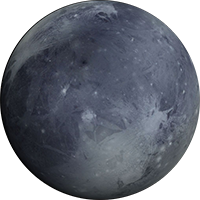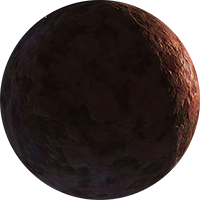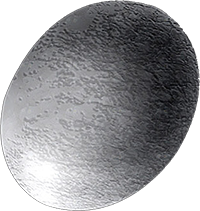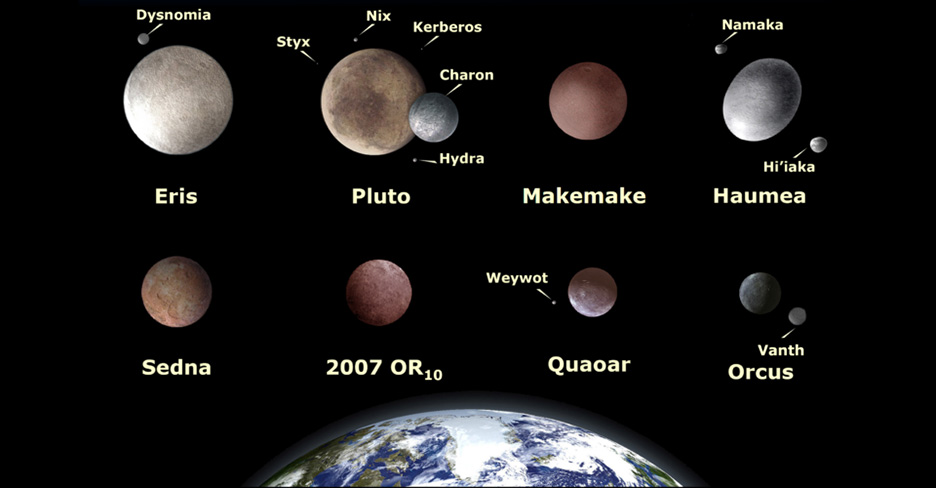Trans-Neptunian Objects
The area beyond Neptune, or the "trans-Neptunian region", is still largely unexplored. It appears to consist overwhelmingly of small worlds (the largest having a diameter only a fifth that of Earth and a mass far smaller than that of the Moon) composed mainly of rock and ice. This region is sometimes known as the "outer Solar System", though others use that term to mean the region beyond the asteroid belt.
 Eris (68 AU average) is the largest known scattered disc object, and caused a debate about what constitutes a planet, because it is 25% more massive than Pluto[110] and about the same diameter. It is the most massive of the known dwarf planets. It has one known moon, Dysnomia. Like Pluto, its orbit is highly eccentric, with a perihelion of 38.2 AU (roughly Pluto's distance from the Sun) and an aphelion of 97.6 AU, and steeply inclined to the ecliptic plane.
Eris (68 AU average) is the largest known scattered disc object, and caused a debate about what constitutes a planet, because it is 25% more massive than Pluto[110] and about the same diameter. It is the most massive of the known dwarf planets. It has one known moon, Dysnomia. Like Pluto, its orbit is highly eccentric, with a perihelion of 38.2 AU (roughly Pluto's distance from the Sun) and an aphelion of 97.6 AU, and steeply inclined to the ecliptic plane. Pluto, formal designation 134340 Pluto, is the second-most-massive known dwarf planet in the Solar System (after Eris) and the tenth-most-massive body observed directly orbiting the Sun. Originally classified as the ninth planet from the Sun, Pluto was recategorized as a dwarf planet and plutoid owing to the discovery that it is only one of several large bodies within the Kuiper belt.
Pluto, formal designation 134340 Pluto, is the second-most-massive known dwarf planet in the Solar System (after Eris) and the tenth-most-massive body observed directly orbiting the Sun. Originally classified as the ninth planet from the Sun, Pluto was recategorized as a dwarf planet and plutoid owing to the discovery that it is only one of several large bodies within the Kuiper belt. Makemake (45.79 AU average), although smaller than Pluto, is the largest known object in the classical Kuiper belt (that is, it is not in a confirmed resonance with Neptune). Makemake is the brightest object in the Kuiper belt after Pluto. It was named and designated a dwarf planet in 2008. Its orbit is far more inclined than Pluto's, at 29°.
Makemake (45.79 AU average), although smaller than Pluto, is the largest known object in the classical Kuiper belt (that is, it is not in a confirmed resonance with Neptune). Makemake is the brightest object in the Kuiper belt after Pluto. It was named and designated a dwarf planet in 2008. Its orbit is far more inclined than Pluto's, at 29°. Haumea (43.13 AU average) is in an orbit similar to Makemake except that it is caught in a 7:12 orbital resonance with Neptune. It is about the same size as Makemake and has two natural satellites. A rapid, 3.9-hour rotation gives it a flattened and elongated shape. It was named and designated a dwarf planet in 2008.
Haumea (43.13 AU average) is in an orbit similar to Makemake except that it is caught in a 7:12 orbital resonance with Neptune. It is about the same size as Makemake and has two natural satellites. A rapid, 3.9-hour rotation gives it a flattened and elongated shape. It was named and designated a dwarf planet in 2008.The Kuiper belt is a great ring of debris similar to the asteroid belt, but consisting mainly of objects composed primarily of ice.[99] It extends between 30 and 50 AU from the Sun. Though it is estimated to contain anything from dozens to thousands of dwarf planets, it is composed mainly of small Solar System bodies. Many of the larger Kuiper belt objects, such as Quaoar, Varuna, and Orcus, may prove to be dwarf planets with further data. There are estimated to be over 100,000 Kuiper belt objects with a diameter greater than 50 km, but the total mass of the Kuiper belt is thought to be only a tenth or even a hundredth the mass of Earth. Many Kuiper belt objects have multiple satellites, and most have orbits that take them outside the plane of the ecliptic.
The Kuiper belt can be roughly divided into the "classical" belt and the resonances. Resonances are orbits linked to that of Neptune (e.g. twice for every three Neptune orbits, or once for every two). The first resonance begins within the orbit of Neptune itself. The classical belt consists of objects having no resonance with Neptune, and extends from roughly 39.4 AU to 47.7 AU. Members of the classical Kuiper belt are classified as cubewanos, after the first of their kind to be discovered, (15760) 1992 QB1, and are still in near primordial, low-eccentricity orbits.
Largest known trans-neptunian objects






